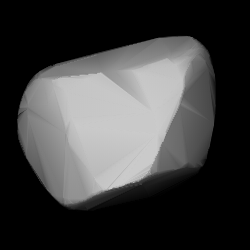Astronomy:246 Asporina
From HandWiki
Short description: Main-belt asteroid
 3D model based on lightcurve data | |
| Discovery | |
|---|---|
| Discovered by | A. Borrelly |
| Discovery date | 6 March 1885 |
| Designations | |
| (246) Asporina | |
| Named after | Asporina |
| A885 EA | |
| Minor planet category | Main belt |
| Orbital characteristics[1] | |
| Epoch 31 July 2016 (JD 2457600.5) | |
| Uncertainty parameter 0 | |
| Observation arc | 130.96 yr (47834 d) |
| |{{{apsis}}}|helion}} | 2.98941 astronomical unit|AU (447.209 Gm) |
| |{{{apsis}}}|helion}} | 2.39768 AU (358.688 Gm) |
| 2.69355 AU (402.949 Gm) | |
| Eccentricity | 0.10984 |
| Orbital period | 4.42 yr (1614.7 d) |
| Average Orbital speed | 18.14 km/s |
| Mean anomaly | 172.414° |
| Mean motion | 0° 13m 22.638s / day |
| Inclination | 15.6259° |
| Longitude of ascending node | 162.347° |
| 96.6218° | |
| Physical characteristics | |
| Dimensions | 60.10±4.2 km |
| Rotation period | 16.222 h (0.6759 d) |
| Geometric albedo | 0.1744±0.027 |
| R | |
| Absolute magnitude (H) | 8.62 |
Asporina (minor planet designation: 246 Asporina) is a sizeable main-belt asteroid. It is classified as one of the few A-type asteroids.
It was discovered by A. Borrelly on 6 March 1885 in Marseilles and was named after Asporina, a goddess worshipped on Mount Asporenus, Asia Minor.[2]
The spectrum of 246 Asporina reveals the strong presence of the mineral olivine, a relative rarity in the asteroid belt.[3]
References
- ↑ "246 Asporina". JPL Small-Body Database. NASA/Jet Propulsion Laboratory. https://ssd.jpl.nasa.gov/sbdb.cgi?sstr=246;cad=1.
- ↑ Schmadel, Lutz (5 August 2003). Dictionary of Minor Planet Names. Springer Science & Business Media. ISBN 9783540002383. https://books.google.com/books?id=VoJ5nUyIzCsC&q=asporina&pg=PA36.
- ↑ Burbine, T. H. et al. (July 2000), "The Nature of Olivine Asteroids", Meteoritics & Planetary Science 35: pp. A35, doi:10.1111/j.1945-5100.2000.tb01796.x, Bibcode: 2000M&PSA..35R..35B.
External links
- The Asteroid Orbital Elements Database
- Minor Planet Discovery Circumstances
- Asteroid Lightcurve Data File
- 246 Asporina at AstDyS-2, Asteroids—Dynamic Site
- 246 Asporina at the JPL Small-Body Database
 |

